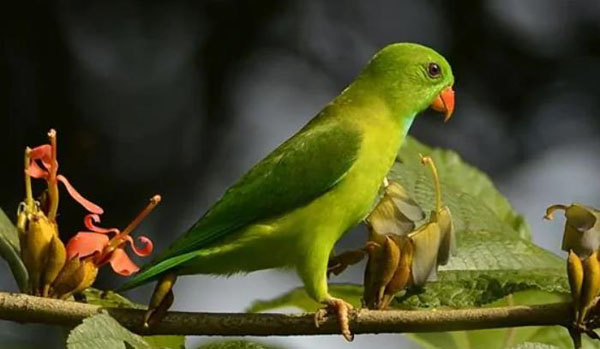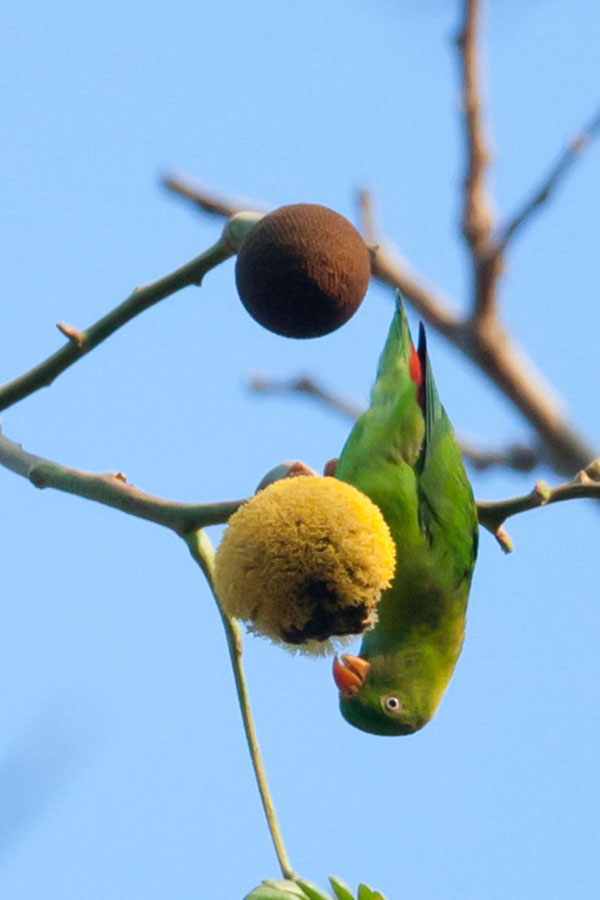Short-tailed Parrot
IUCN
LCBasic Information
Scientific classification
- name:Short-tailed Parrot
- Scientific Name:Vernal hanging parrot, Indian parrot
- Outline:Climbing birds
- Family:Psittaciformes Psittacidae Parrot
Vital signs
- length:90mm
- Weight:130g
- lifetime:8-20years
Feature
It often hangs itself vertically, so it is also called a hanging parrot or a hanging parrot.
Distribution and Habitat
Rarely found in southwestern and southern Yunnan in China, most of its suitable habitats in Yunnan have been lost, and hunting poses a great threat. Abroad, it is found from India to Southeast Asia and Java.
It is an uncommon resident bird in tropical and subtropical evergreen forests. Its wings vibrate with sound when flying, and it climbs around among branches, often hanging upside down.
Appearance
It is short in size, with a red beak, wing lining that is turquoise and greenish, and a red waist. The male has a blue throat, yellow irises, a red beak, and yellow feet.
Details
The short-tailed parrot is a typical climbing bird, with a small body and a tail shorter than the wings; a thin beak, short, strong and powerful legs, two toes forward and two toes backward, suitable for grasping and climbing. The body feathers are mainly green, with a red beak and red waist, and the underside of the wings is turquoise with green wing lining. It likes to move in pairs or small groups, and also mixes with other species. It usually moves in the top of the tree canopy, but sometimes it descends to a lower place in order to find suitable food. It mainly eats nectar and flowers. It is a late-hatched chick.

The short-tailed parrot is a strict arboreal parrot that never lands on the ground, preferring to stay in the top of the dense tree canopy. This bird usually gathers in small groups, and in larger groups when it blooms. They often hang vertically upside down on the branches to peck at the flowers. They are very agile when foraging around the tree canopy, and when flying up a branch, they spiral around the branch. Sometimes the whole flock suddenly leaves the treetops and circles around in the air, calling loudly, and then they are thrown back to the tree and continue pecking. They become very tame, and usually fly fast and bumpy. They feed on soft fruits such as figs, nectar, bamboo and chestnut seeds, and also go to orchards to peck at fruits such as guava and loquat, causing some damage.
Its call is a repeated "chee-chee-chee" scream or a "tsit-tsit" tremor when flying, and occasionally a soft giggle-like sound when eating.

Likes to gather in small groups. It mainly feeds on plants and flowering shrubs, fruits, nectar, fruits such as figs, pears, apples, bananas and vegetable seeds. Because this parrot often likes to hang on branches to rest and play, it is also called hanging parrot or hanging parrot. This is a quiet little parrot, and its melodious chirping can mostly be heard at night.
Nests in tree holes, and sometimes directly use abandoned old nests. The breeding season is between January and April. It is listed in the second level of the "List of National Key Protected Wildlife in China".








